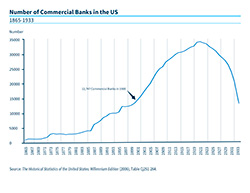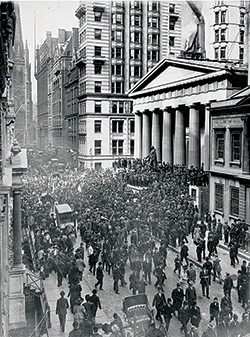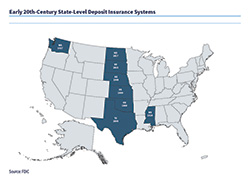There are 12,427 commercial banks operating in the United States.

Chart of the number of commercial banks operating in the United States in 1900
October 1907
Panic of 1907
The Panic of 1907 was severe, with New York City trust companies at its center. Having grown rapidly during the decade before the panic, trust companies' total assets and loan and deposit volumes were almost equal to that of the city’s national banks. Their growth was facilitated by comparatively less stringent regulation: trust companies faced lower reserve requirements and fewer restrictions on the types of assets they could hold, but they competed with banks for deposits and like banks, their deposits were demandable on short notice and thus susceptible to runs. Moreover, trust companies’ institutional structures and functions as financial intermediaries made them potentially more vulnerable to financial system shocks. While holding lower reserves against deposits, they were not part of the clearinghouse system and so lacked the ability to access funding in times of crisis. In addition, trusts were active in underwriting and the distribution of securities and provided large amounts of loans in the stock market.
Preceded by an economic slowdown, the panic was precipitated by the failed attempt by speculators Augustus Heinze and Charles Morse to corner the shares of the United Copper Company. This eroded depositor confidence in banks associated with the copper speculators and led to runs on these banks. An immediate response by the New York Clearinghouse (NYCH) to assist these troubled banks quickly ended the runs. However, depositor fear spread to the trust companies beginning on October 21 when they ran the Knickerbocker Trust as it became depositors became aware that its president was an associate of the copper speculators. Runs on other trusts quickly followed. The trust companies lacked the mechanisms NYCH member banks had to coordinate responses and resist depositor runs, and the NYCH was unwilling to intervene because the trusts were seen as rivals of its member banks for deposits.
The financier and investment banker J.P. Morgan was called upon to fill the leadership vacuum, coordinate the response of trust companies, raise the necessary funds to rescue them, and end the panic. The U.S. Treasury also provided critical support to Morgan's plan. Nevertheless, the effect on trust companies was severe. Total loans made by trust companies decreased more than a third between August and December 1907. A serious economic downturn followed the panic. While the economy was declining before the crisis, real gross domestic product (GDP) declined 11 percent, industrial production fell 16 percent, and unemployment increased over the following year. The panic would serve as a catalyst for the establishment of the Federal Reserve System in 1913.

Image from the Panic of 1907
December 17, 1907
An Oklahoma law for the guaranty of deposits is approved, effective February 14, 1908. After surviving serious financial difficulties early in its existence, a wave of bank failures in 1920 and 1921 meant that the system’s fund was inadequate to meet its obligations. By late 1921, the system no longer protected depositors, and in 1923 the law establishing the system was repealed.
For a brief discussion of the eight deposit insurance systems of the early 20th century, see FDIC Annual Report, 1956, 49ff, https://www.fdic.gov/about/financial-reports/reports/archives/fdic-ar-1956.pdf .

Map of the eight deposit insurance systems of the early 20th Century
May 30, 1908
The Act to Amend the National Banking Laws (known as the Aldrich-Vreeland Act) is signed into law by President Theodore Roosevelt.
The Aldrich-Vreeland Act was a legislative response to the panic of 1907. One defect of the banking system at that time was the requirement that national banknotes be backed by government bonds, which meant banks could not easily increase the currency supply in response to increased demand for money. This was particularly problematic during a panic. Although clearinghouse actions on behalf of their member banks could ameliorate this difficulty, their response was not always reliable. To remedy this problem, some currency reform bills called for the creation of asset-based currency in which banknotes were backed by a bank’s assets.
The law represented a compromise between a bond-secured and an asset-based currency. The act allowed national banks, with the approval of the U.S. Treasury, to form national currency associations that could issue emergency currency, allowing banks to circulate additional currency during a panic when there was a sudden increase in demand. The associations had to deposit securities with the Treasury in the form of government bonds and their own assets. The act placed a tax on the issuance of emergency currency to ensure its quick retirement upon the return of normal conditions and set a $500 million aggregate limit on circulation. The Aldrich-Vreeland emergency currency was used only once, to stem a panic in 1914. The statute also established the National Monetary Commission, which was tasked with advising Congress on reforming the banking and financial system. The Commission studied the monetary and banking systems in European countries and produced numerous reports. Its work ultimately contributed to the creation of the Federal Reserve System.
March 6, 1909
A Kansas law for the guaranty of bank deposits is approved, effective June 30.The Kansas system is voluntary, but many banks join the system, which operated successfully until the failure of the largest bank in the system in 1923. Banks began withdrawing from the system, and most withdrew after a 1926 court decision limited their liability for assessments to handle losses in failures that had already occurred. Although at this point the system was insolvent, the law that established it was not repealed until 1929.
For a brief discussion of the eight deposit insurance systems of the early 20th century, see FDIC Annual Report, 1956, 49ff, https://www.fdic.gov/about/financial-reports/reports/archives/fdic-ar-1956.pdf .

Map of the eight deposit insurance systems of the early 20th Century
April 6, 1909
The first credit union in the United States, St. Mary's Cooperative Credit Association, opens in Manchester, New Hampshire.
April 25, 1909
A Nebraska law for the guaranty of bank deposits is approved, but it did not become effective until July 1, 1911, due to litigation as to its constitutionality. For almost 16 years, the system fully paid its obligations to depositors. By 1930 its liabilities were far greater than its resources, and its guaranty was no longer applicable to future failures. In 1932, the State Supreme Court declared that all assessments made after 1928 had been unconstitutional. In 1933, the entire law was repealed and the system's affairs were wound down in 1934.
For a brief discussion of the eight deposit insurance systems of the early 20th century, see FDIC Annual Report, 1956, 49ff, https://www.fdic.gov/about/financial-reports/reports/archives/fdic-ar-1956.pdf .

Map of the eight deposit insurance systems of the early 20th Century
May 12, 1909
A Texas law for the guaranty of bank deposits is approved, effective January 1, 1910. This was the most successful of the state guaranty systems, meeting all of its obligations until the mid-1920s. However, the cost of special assessments to cover guaranteed depositor losses grew high. Under pressure from bankers, the Texas legislature changed the law so that most banks could withdraw from the system. In 1927 the law was repealed.
For a brief discussion of the eight deposit insurance systems of the early 20th century, see FDIC Annual Report, 1956, 49ff, https://www.fdic.gov/about/financial-reports/reports/archives/fdic-ar-1956.pdf .

Map of the eight deposit insurance systems of the early 20th Century
January 1, 1911
The Postal Savings System begins operations, having been authorized by statute in 1910. The system was meant to promote thrift and attract savings from immigrants and other small savers, drawing “money under the mattress” into the financial system. In response to populist and progressive support for a national deposit insurance system in the wake of the Panic of 1907, Republican politicians saw the Postal Savings System as a more palatable option, and President William Howard Taft supported it. Postal savings deposits were backed by the full faith and credit of the United States, so depositors could view them as extremely safe. Banker opposition to the system was assuaged by requiring that the bulk of money deposited with the Postal Savings System be redeposited in local banks, mandating that the system pay low interest rates and limiting the amount an individual could deposit to $500 (this would be raised to $1,000 in 1916 and to $2,500 in 1918). The system stopped taking deposits in 1966 and closed on July 1, 1967.
December 23, 1913
The Federal Reserve Act is signed into law by President Woodrow Wilson.
The need for a U.S. central bank was increasingly evident after the Panic of 1907, but a law creating the Federal Reserve System was enacted only after several years of discussion and failed legislative action in 1911–12. The legislation created a system of regional privately owned Federal Reserve banks. One important question during the bill’s passage was the level of central government control over these banks. The final bill specified that there be between eight and twelve regional Federal Reserve Banks and a central Federal Reserve Board.
https://www.federalreservehistory.org/essays/federal-reserve-act-signed
March 9, 1914
A Mississippi law for the guaranty of bank deposits is enacted. The system remained in operation until 1930, but because of bank failures was experiencing difficulties by the early 1920s. By 1930 its liabilities far exceeded any resources it might obtain, and in that year the use of the fund for future failures was suspended until its liabilities were met; the law was repealed in 1934.
For a brief discussion of the eight deposit insurance systems of the early 20th century, see FDIC Annual Report, 1956, 49ff, https://www.fdic.gov/about/financial-reports/reports/archives/fdic-ar-1956.pdf .

Map of the eight deposit insurance systems of the early 20th Century
March 5, 1915
A South Dakota law for the guaranty of bank deposits is enacted, effective January 1, 1916. By 1923, due to the large number of failures, the guaranty fund could no longer meet its obligations to depositors, and the system was discontinued in 1927.
For a brief discussion of the eight deposit insurance systems of the early 20th century, see FDIC Annual Report, 1956, 49ff, https://www.fdic.gov/about/financial-reports/reports/archives/fdic-ar-1956.pdf .

Map of the eight deposit insurance systems of the early 20th Century
March 10, 1917
A Washington law for the guaranty of bank deposits is enacted, effective June 1917. Washington’s guaranty system, the last state system established, was the first to cease operations. On June 30, 1921, the largest bank in the state failed, and the guaranty fund was insufficient to handle the payment to insured depositors. Facing a large assessment in 1922, all of the participating banks withdrew from the system as permitted by law.
On the same day, a North Dakota law for the guaranty of bank deposits is enacted, effective July 1, 1917, but because of the time required to examine banks for admission, actual insurance was not provided until July 1, 1918. During the first two years under the system, two banks failed and their depositors were promptly paid. But from 1921 onwards, many banks closed in the state, and there were legal issues surrounding payment to depositors that were not resolved until 1924, after which at least some depositors were paid 10 percent of their claims. By the mid-1920s the fund was clearly insolvent and the law that created the system was repealed effective July 1, 1929. In 1931 a law passed which used the fund’s remaining assets to pay depositors who had not previously received a payment one percent of their claims.
For a brief discussion of the eight deposit insurance systems of the early 20th century, see FDIC Annual Report, 1956, 49ff, https://www.fdic.gov/about/financial-reports/reports/archives/fdic-ar-1956.pdf .

Map of the eight deposit insurance systems of the early 20th Century
